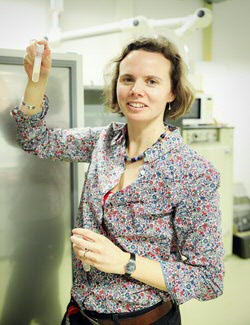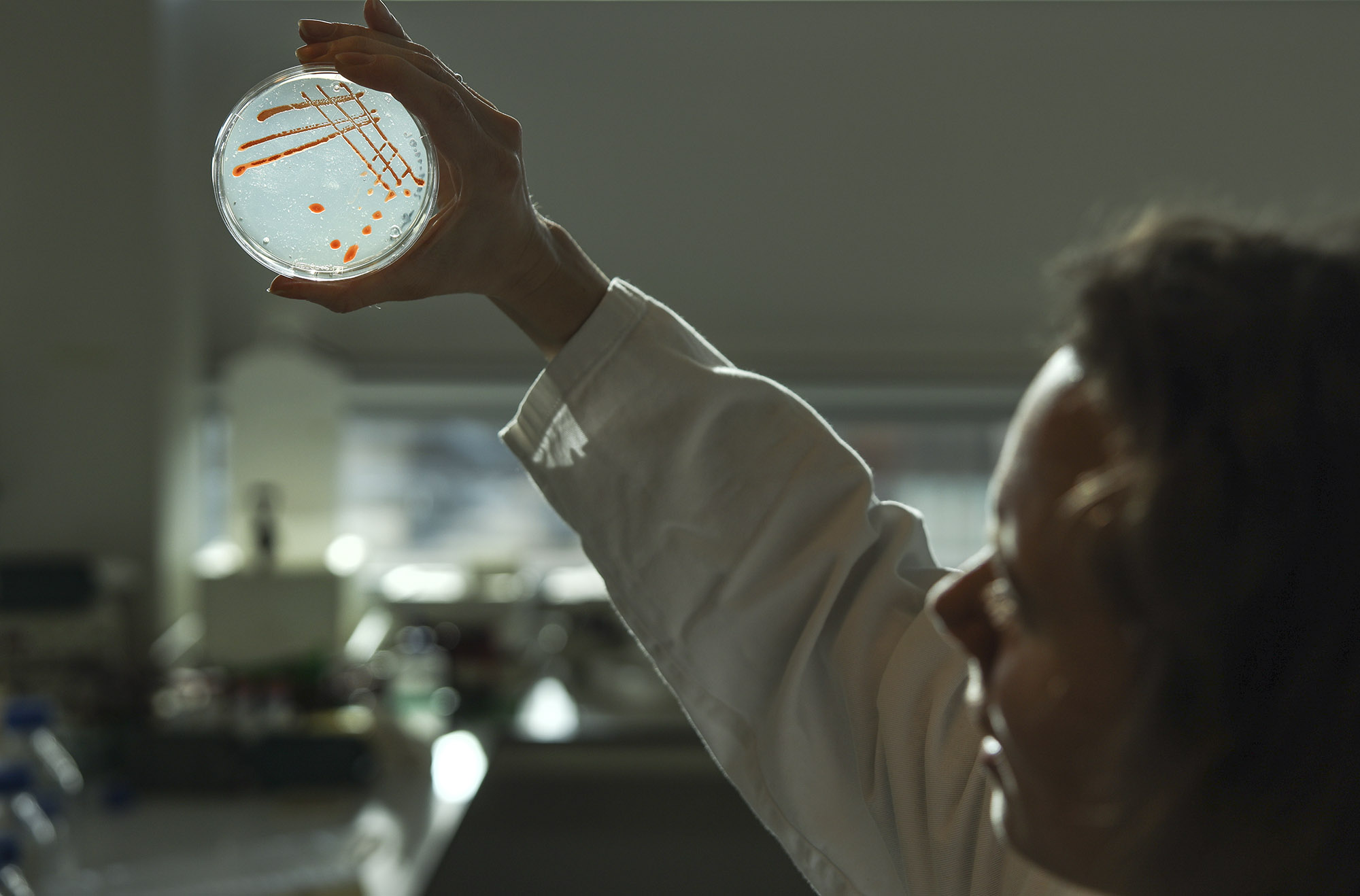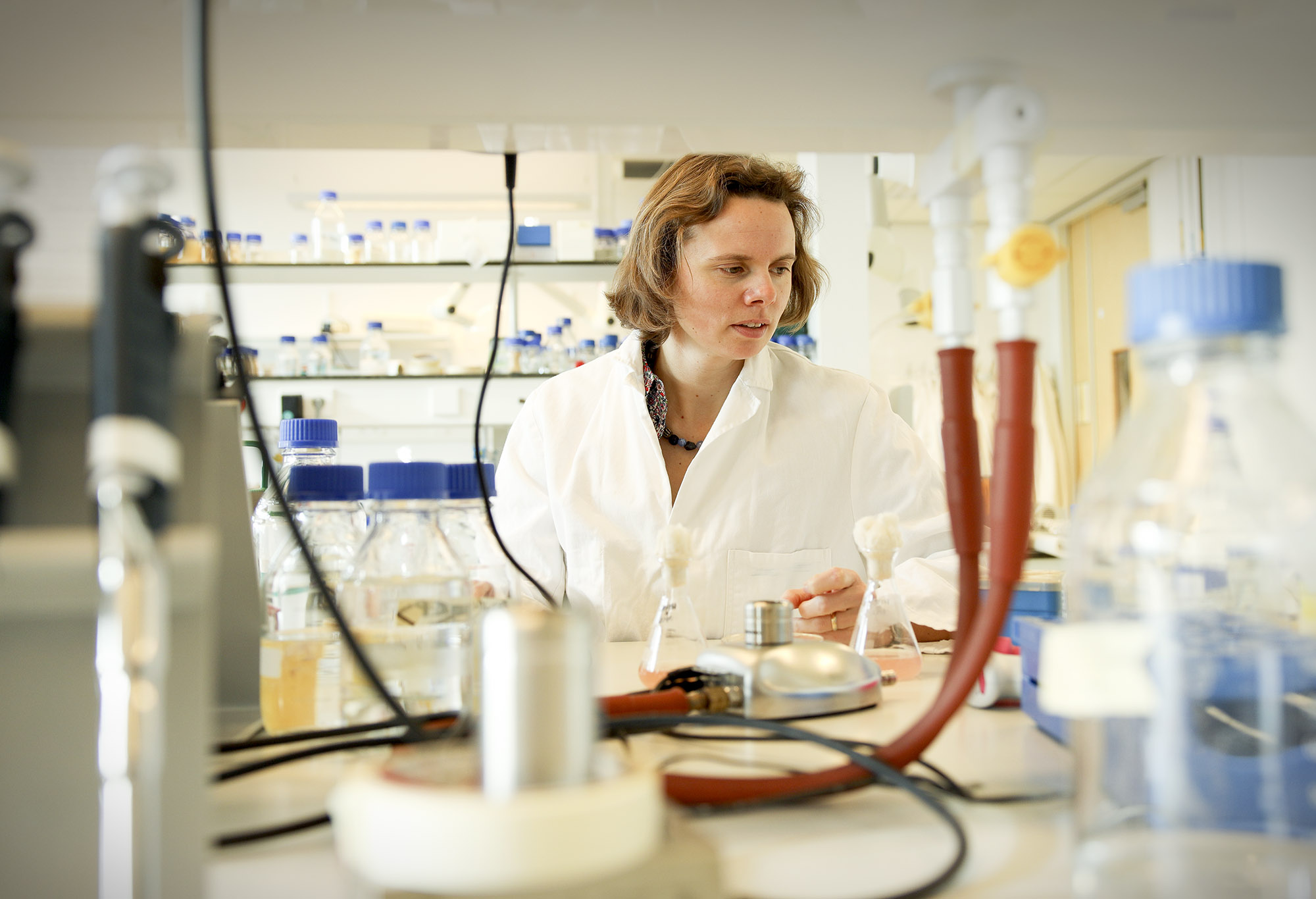The single-celled microworld of Tessa Quax

She receives prize after prize and grant after grant: lately, researcher and professor of microbiology Tessa Quax has been making headlines. The biologist researches archaea, single-celled microorganisms that lack a cell nucleus and flourish in extreme circumstances. Her eye-opening research sheds new light on viruses, which also afflict archaea, but Quax does it all out of curiosity and for her own field. ‘I just want to know how something works. There is no need to have a goal.’
Text: Thomas Vos / Photos: Henk Veenstra
‘Everything that we see—people and animals—consists of multiple cells. But, to be honest, the tree of life on Earth mainly consists of microorganisms that we cannot see; for example, single-celled archaea. They have so many more abilities than us; they were there before us, and they will still be there after we are gone. I find it fascinating, it truly is a discovery for me,’ Quax says.
Recognition
Quax is a born scientist. She makes observations or asks herself something, and then starts researching, trying to find an explanation. She has been this curious throughout her whole life, and her curiosity is the motivation behind her work. This is something that was not able to go unnoticed. Recently, Quax was awarded an Early Career Award by the Royal Netherlands Academy of Arts and Sciences (KNAW). In January, she also received a grant from the European Research Council (ERC), as well as the Beijerinck Premium (of the KNAW) designated for young virologists.
Fascinated by archaea
Archaea first sparked something in Quax when she was studying biology in Utrecht. ‘A lecturer showed us images of places where archaea can grow, such as salt lakes or volcanic springs. I was very surprised to see that life is possible in such environments, and I wanted to keep researching it.’ Archaea can tell us a lot about the origins of life. I was sold immediately.’ Now, Quax is a Rosalind Franklin Fellow at the UG. This career path was established by the University specifically for promising female academics. She has her own Quax lab for researching archaea. But, perhaps more importantly: her contributions are crucial for the creation of a completely new research field focused on the interaction between archaea and viruses.

Ancient viruses
After holding positions in places including Leuven and Freiburg, in the summer of 2021 Quax became a professor at the Faculty of Science and Engineering at the UG. As part of her research here, she investigates the viruses that archaea carry around: ‘Humans, animals, and plants can get infected by viruses, and archaea are no exception. In this case, the virus is present where the archaea grow—for example, volcanic springs— and can kill the organisms.’ For Quax, the following question is important: where do those viruses come from? She says: ‘The work that we do shows that these viruses really are super old. Some even claim that the viruses were there before the cells came into existence.’
Beautiful shapes
Archaeal viruses do not look like ‘normal’ viruses. She says: ‘The coronavirus looks like a pretty sphere with spikes. You can see such spheres often when it comes to viruses. When it comes to bacteria, we usually see a sphere with a ‘tail’ and ‘feet’ that can land on the surface of the cell. However, archaeal viruses can take many shapes. A spiral, a stick, a bottle... You name it.’ In particular, Quax studies how viruses attack and then leave archaea. She has already made an important discovery in this field: ‘We discovered new mechanisms. The viruses create pyramid-shaped “doors” in the archaea to leave the cell. It is completely different from the way other viruses function and is therefore unique to archaea.’
Pioneering work
In her own lab, Quax investigates the infection mechanisms of archaeal viruses. To this end, she works together with students and researchers. Each of them research their own virus, or investigate the hosts—the archaea. The lab is still young; Quax and her colleagues started working there in October 2021. She says: ‘Building a lab together is great, but it is also exciting to start working on new research lines. Some mornings I think to myself: “Where should I start?” But it gives me energy. There is still so much to discover, as if we were on an expedition. We have to develop everything ourselves—for example, good research tools. It really is pioneering work.’

Curiosity
Because this is pioneering research, its direct benefit is not necessarily evident. But for her, it does not matter: ‘I just want to know how something works. There is no need to have a goal. Curiosity is normal for us as humans, we want to understand things.’ Yet, she does not ignore the application possibilities: ‘With such research, there are always multiple forms of application. Archaea live in sheep and cow intestines and ensure high methane production. This can be lowered through special diets, and viruses can also play a role here. The research can teach us something about viruses that attack people, but those sorts of application should not be forced. The best innovations happen accidentally.’
Viruses as a part of life
Her research definitely helps to develop a new perception of viruses. She says: ‘Not all viruses are similar to the coronavirus—in the case of the latter, you get ill and your body subsequently gets rid of the virus. When it comes to microorganisms, the relations between the host and the virus are often more long-lasting and stable. Sometimes there are even advantages for the host: for example, the virus protects the cell from other deadly viruses. In the past two years, viruses have gained a very bad reputation, but in my field we actually are trying to create an image of viruses as a permanent part of our life. In nature, cells constantly get infected. Our research community is therefore also growing.’
Inspiring others
You can notice the increase in attention for this research by the prizes and grants that Quax has received in a short time span. She says: ‘I am very happy about that. I hope that people will follow their curiosity and that it will inspire younger people to investigate how things work by doing research. You do that to learn something, not for the products that the research will result in. If you learn to stimulate that, it will result in something beautiful by itself.’
More news
-
11 December 2025
Stormy planets and an unexpected atmosphere
-
09 December 2025
University of Groningen Professor at COP30: ‘There is always drama’
